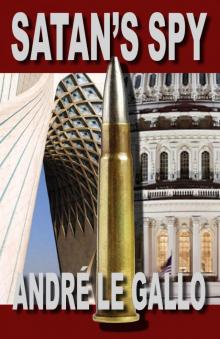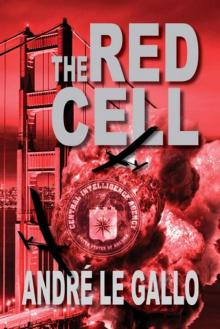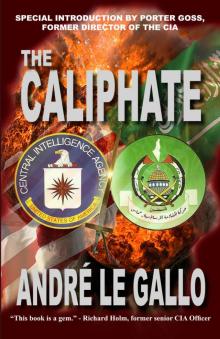- Home
- André Le Gallo
The Red Cell
The Red Cell Read online
THE RED CELL
André Le Gallo
Also by André Le Gallo:
The Caliphate
Satan’s Spy
The Red Cell
By André Le Gallo
© 2021 André Le Gallo
Original copyright © 2016
All Rights Reserved
Published in the United States of America
By D Street Books
A division of Mountain Lake Press
Cover design by Jutta Medina
No part of this book may be reproduced, stored in a data base or other retrieval system, or transmitted in any form, by any means, including mechanical, electronic, photocopying, recording, or otherwise, without the prior written permission of the author.
All statements of fact, opinion, or analysis expressed are those of the author and do not reflect the official positions or views of the CIA or any other U.S. Government agency. Nothing in the contents should be construed as asserting or implying U.S. Government authentication of information or Agency endorsement of the author’s views. This material has been reviewed by the CIA to prevent the disclosure of classified information.
To Cathy
Everyone’s cheerleader, the co-author of my life,
the center of my existence…
To my parents…
And to the American soldiers who liberated France.
Contents
FOREWORD
PROLOGUE
1. Old Executive Office Building, Washington
2. Fairfax County, Virginia
3. CIA Headquarters, Langley, Virginia
4. Damascus
5. Alexandria, Virginia
6. The White House, West Wing
7. Washington
8. Larnaca, Cyprus
9. Bucharest
10. Langley
11. Brussels
12. Silicon Valley, California
13. New York
14. Mechelen, Belgium
15. Charleroi, Belgium
16. Free University of Brussels
17. Brasserie Gaillard, Brussels
18. Charleroi
19. Kristen’s Apartment
20. Waterloo, Belgium
21. Svetlana’s House
22. Iranian Safe House, Charleroi
23. Avenue Wellington
24. Aisha’s Apartment
25. The White House
26. Back at Kristen’s Apartment
27. Iranian Embassy, Brussels
28. Zaventem Airport
29. Ramstein Air Force Base, Germany
30. Grande Place, Brussels
31. The ‘Croatians’
32. The ‘Bulgarians’
33. Paris
34. United Nations, New York
35. Langley Redux
36. Sausalito, California
37. McLean, Virginia
38. Golden Gate Bridge
39. Tiburon, California
40. New York Redux
41. Marin Headlands
42. The White House and a Federal Building in San Francisco
43. Tiburon Compound
44. Camp Pendleton Marine Corps Base, California
45. Beirut
46. The Knolls, San Rafael, California
47. Golden Gate Bridge and Marin Headlands
Friday, 0210 hours
0445
0500
0505
0515
0530
0530
0530
0538
0540
0540
0545
0550
0555
0600
0600
0605
0605
0610
0610
48. Rodeo Beach
49. The Oval Office
AFTERWORD
ACKNOWLEDGEMENTS
ABOUT THE AUTHOR
FOREWORD
The definition of an unsung hero is one you don’t know about. So you have not heard, in all probability, of this author. I have, because we shared a training course in 1963. It was no ordinary classroom yawn. It was the CIA training for future operations officers—rigorous, physically and mentally challenging, sometimes sleep deprived, and sometimes demanding the spontaneous invention of a scenario for an unfolding operation.
The canvas of a would-be operations officer starts with a foreign problem or even quagmire that demands insights—covertly acquired intelligence—in order to understand the true situation, or the true intentions of an antagonist.
The training scenarios attempted to prepare us to deal with people from very different cultures, on foreign lands that might be unwelcoming. We also understood we would often be alone in using our assessment skills with a foreigner whom we hoped could be convinced to be receptive to our needs.
A winning, compassionate personality would help. Not to mention “think on your feet” adjustments to surprising information, or hints that a person you wanted to trust was not quite what he wanted you to believe.
The thing I remember most from the first week of that training was the quality of the men and a few women who were my new colleagues. It wasn’t just that they had good educations, law or other advanced degrees, or living experience abroad. More than that, they were bright, quick-witted, admirable young Americans, all eager to serve their country. And the author of this book, André Le Gallo, was a standout.
André didn’t try to be a standout. Indeed, we understood from our training it was much better NOT to be noticed. Not to call attention to our covert activities. Not to be labeled by a foreign intelligence service as “probably a CIA officer”. Better to be, or seem to be “unsung.”
But André’s background was different than most of ours. And in time, I learned that his boyhood in Brittany, France included staying out of the way of and playing tricks on Nazi soldiers during World War II. He already knew a thing or two about real life deception and guile. But in training André was solid and sensible and dependable. You wanted him on your side.
Then we all went off into the Cold War to, in fact, serve our country. André journeyed to Laos to lead mountain tribes as his first challenge. I went in a different direction to serve. But we were in touch—not often—over the next thirty-five years of adventure and innumerable scenarios. André became very, very good as an intelligence officer. You will have to take my word for that. But near the end of those many years, I was in a position to see some of the outstanding bits of one of his fine operations. It comes as no surprise to see another scenario, this time his third novel, from my old comrade.
I’m not going to tell you anything about his story:
EXCEPT that it, like a James Bond adventure, will keep you on the edge of your chair.
EXCEPT that when he tells you a detail of a place in Brussels or Bucharest or Tehran, it is because he still remembers it vividly from his travels there.
And EXCEPT when he describes the nasty symptoms one of his characters has suffered from the disease known as ALS, it reflects his courage in personally facing that condition.
Enjoy your read, and know you are in the hands of a distinguished, unsung American.
—Thomas Twetten
Former Deputy Director Operations, Central Intelligence Agency
Iran has been at war with the United States since the 1979 Ayatollah Revolution, when it held American diplomats hostage for 444 days. The Red Cell attempts to provide a fictional but realistic glimpse into the covert war that never reaches the general public’s awareness.
PROLOGUE
Karbala, Iraq
BBC—Thousands of Shias will flock to Karbala today on the day of Ashura, which commemorates the martyrdom of Hussein, grandson of the Prophet Muhammad, kill
ed by a pretender to the leadership of Islam. In the belief of Shias, Hussein should have succeeded his father Ali as the next Imam. The split between Sunnis and Shias is often dated to this event, which is considered the foundation stone for the Shiite faith and which occurred in the year 61 of the Muslim calendar (October 2, 680 A.D.).
The little girl watched from her window as the poster of a man’s head, mouth open in agony, eyes looking up to Allah, blood on his forehead, moved slowly past in the midst of thousands of marching men who covered the broad avenue and both sidewalks. She barely noticed the black pole smeared with red on which the head was fixed and she hardly registered the saddled but riderless white horse behind the garlanded poster or the green Islamic flags. She searched the moving crowd for her brother.
Her lips formed the cadenced sounds coming from the marchers, “Oh Hussein, oh Hussein, oh Hussein, oh Hussein…” in endless repetition, each incantation punctuated by the hollow sound of the men beating their chests with their fists in unison. The rhythmic sound and gestures had slipped the men into a hypnotic trance. Bare-chested true believers flagellated themselves with small blades attached to chains and cords they flicked over their shoulders and rendered their backs bloody. And none could resist the opportunity to curse Israel and America.
“Come help,” called the girl’s mother, who was dressed in a black shador like the other women in the room. Framed pictures of Hussein in a green cape who bore a striking resemblance to Jesus took the eye away from the peeling white paint.
They walked to a cradle, the mothers or sisters of martyrs or of male relatives soon to be martyrs, filled with candies, sweets, and toys. “Here take a corner.” Her mother gave the girl a cloth and together they stretched it over the canopy. “This is for Hussein’s infant son.” She looked at her daughter. “He was killed before he could sleep in it.”
The other women gathered around the cradle and listened, though they sobbed quietly.
“A hundred thousand of Yazid’s soldiers surrounded Hussein, May Allah Bless Him and his seventy-two warriors, right here in the desert where this city was later built. It was a battle between good and evil. Our people were dying of thirst but, when Hussein walked out from his camp and held his son above his head imploring Yazid’s troops for water for all the children, an arrow pierced his son’s neck.” She touched her throat and grimaced.
The women howled in grief. The little girl clung to her mother in fear.
“Afterward, Imam Hussein’s stallion, Lahik, dipped his head in the Imam’s blood and went back to the camp where he hit his head on the ground and shed tears.”
The mourning women beat their breasts and wailed. Another of them took up the story through her tears. “At the same time, two doves dipped their wings in Hussein’s blood and flew to Medina and then to Mecca where everyone understood the signs and cried.”
“And Hussein’s daughter Sukeyna, poor child, searched the battlefield for the body of her father,” a third woman said. “Hussein’s struggle, May Allah protect him, was a struggle against injustice, tyranny, and oppression, a fight that will only end when revenge…”
An explosion overwhelmed and shut out all other sounds, interrupting her. The walls of the house shook and rumbled. Before anyone could react, another blast, louder and closer, broke the momentary silence that followed the first and shattered the window sending shards of glass flying like arrows through the shadors into soft flesh. The girl felt her mother’s blood on her face as both were knocked to the floor.
Outside, men ran toward side streets. Others, veterans of the Iraq-Iran war, had hit the ground immediately. In front of a public building blood and body parts were still flying through the air together with pieces of the car that had concealed the bomb. Many of those lying face down were killed by mortar rounds flying in over the roof tops.
AL JAZEERAH—Karbala, Iraq. Insufficient security measures by occupying American troops allowed a car bomb, several suicide bombers and a mortar attack to kill over 200 and wound 1000 more during the traditional Shiite holiday of Ashura. An American spokesman in Baghdad denied the security lapse had been planned.
BBC—A coordinated attack allegedly designed to fuel a religious war between Iraqi Sunnis and Shias killed over one hundred and fifty and wounded five hundred Shia pilgrims in the holy city of Karbala in Iraq today. Al Qaeda in Mesopotamia is believed to be responsible for the carnage.
1. Old Executive Office Building, Washington
When Steve Church drove out of his office’s underground parking onto 17th Street, Northwest, the sudden eruption of white fumes from a motorcycle in his rearview mirror awakened his operational awareness, which had been dulled by a year heading the White House’s Intelligence staff. As he headed south toward Constitution Avenue, he kept an eye on the two bikers, both in black leather, who were sharing a midsize Japanese motorcycle now two cars behind him. With a threatening roar, the bike moved up a car closer, straddling the white lane divider. At the same time, the driver lowered the black visor of his helmet like a knight preparing for battle, while his rider removed something from the bike’s saddle bag.
Feeling a growing sense of paranoia, Steve transferred his gun from the glove compartment to the map slot in the driver’s door. Having narrowly escaped from Iran a year before, carrying that country’s top-secret plans for a devastating cyber attack on the United States, Steve immediately assumed the bikers to be an Iranian hit team, unless of course they were peaceful commuters on their way home.
He turned right on Constitution and then made an immediate half-right onto Virginia Avenue, before a red light forced him to stop. The motorcycle pulled up next to him on the passenger side, just as the light turned green. Steve thought he heard a metallic clunk, but it was quickly overwhelmed by the bike’s roaring takeoff. He managed to keep close enough behind to see them turn right at the end of Virginia onto the Rock Creek Parkway, before he pulled into the gas station just beyond the Watergate West condominium tower.
As he rounded the car toward the gas pumps, he discovered the source of the sound he had heard a few minutes before. It was a round black box attached to his passenger door. He recognized it instantly as a limpet mine, an IED used by the Mojahedin-e-Khalq, the MEK, to assassinate their targets, most recently Iranian nuclear scientists. His first thought was to pull it off and hurl it across the street into a vacant lot. But just then a utility truck pulled up to the other side of the pump. Steve raced toward the vehicle and pulled the emerging driver, a ruddy-faced, forty-something man in white overalls, to the pavement, yelling, “Get down, get down!”
Although Steve’s heart was pounding and the adrenaline was flowing, his mind was on automatic; his instincts were in charge.
Before Steve could finish his warning, the device exploded.
The sound was deafening, but fortunately the mine was small enough its force projected mostly sideways into his car and did not ignite the gas pumps—though the interior was engulfed in flames, and the passenger door looked like it had been penetrated by a rocket-propelled grenade.
His ears ringing, Steve took a breath and checked that his new friend was okay. He quickly stood up and ran to the driver’s side of his car to retrieve the Glock. He managed to yank the door open and retrieve the gun before the fire could ignite its ammunition. Then, surrounded by stunned onlookers, he ran back to the other driver, who was now sitting up and shaking his head.
“I need to borrow your truck,” Steve said in a rush. “Wait here. I’ll be back.”
He opened the door, which was labeled “Hansen Glass,” and jumped in. “Tell the police I’m going after those guys,” he called out, starting the engine and roaring away from his still-burning vehicle, just as the first sounds of sirens could be heard.
Steve had to think fast. He had seen the motorcycle heading up the parkway, but where to? Were they trying to get to the Pakistan Embassy on Connecticut Avenue? The Pakistanis handled Iranian affairs in the United States. Possibly, but the longer they sta
yed on the streets of the capital, the more likely they’d be picked up by surveillance video. The police would know where they were trying to hide.
No, he decided. They had probably looped up the ramp to the elevated Whitehurst Freeway and were going to try to thread the rush-hour traffic on Key Bridge to the George Washington Parkway, on the Virginia side of the Potomac. From there, they could reach the Beltway and make their escape on one of its many exits around the city—or even roll out of town completely, maybe seeking to end up at the Iranian Legation in New York.
He had another problem: His would-be assassins could snake through the rush-hour traffic on a two-wheeled motorcycle, while he was driving, he discovered, a truck carrying a six-by-nine-foot pane of glass, which was still in one piece, perhaps because it was on the side away from the explosion.
In a flash he cancelled his first plan of pursuing the bike by taking the ramp to the Whitehurst. Instead, he suddenly veered across the parkway onto the narrow ramp to K Street under the freeway. As he did, the truck’s GPS monotone voice warned, “You have made an incorrect turn. You have made an incorrect turn.” Steve grinned, shutting off the device and pushing the truck toward Wisconsin Avenue, turning right up the hill into the heart of Georgetown.
When he and Kella had been trying to reach the Iranian Gulf while on the run from Iranian security, he was the rabbit. Now, he was the hunter, but he didn’t equate his action—stealing Iranian plans to attack the United States—with this attempt on his life. He laid on his horn, doing his own bit of clumsy threading, trying to get down M Street to the point where the freeway ended and the men on the bike would be circling around the feeder lane to Key Bridge.
He was almost there, having resorted to confronting oncoming traffic, narrowly missing pedestrians, and at one point swerving onto the sidewalk, when … there they were! By the barest stroke of luck, the combination of crawling traffic and their misjudgment that they had nailed Steve had kept them within reach.

 Satan's Spy (The Steve Church saga Book 2)
Satan's Spy (The Steve Church saga Book 2) The Red Cell
The Red Cell The Caliphate
The Caliphate